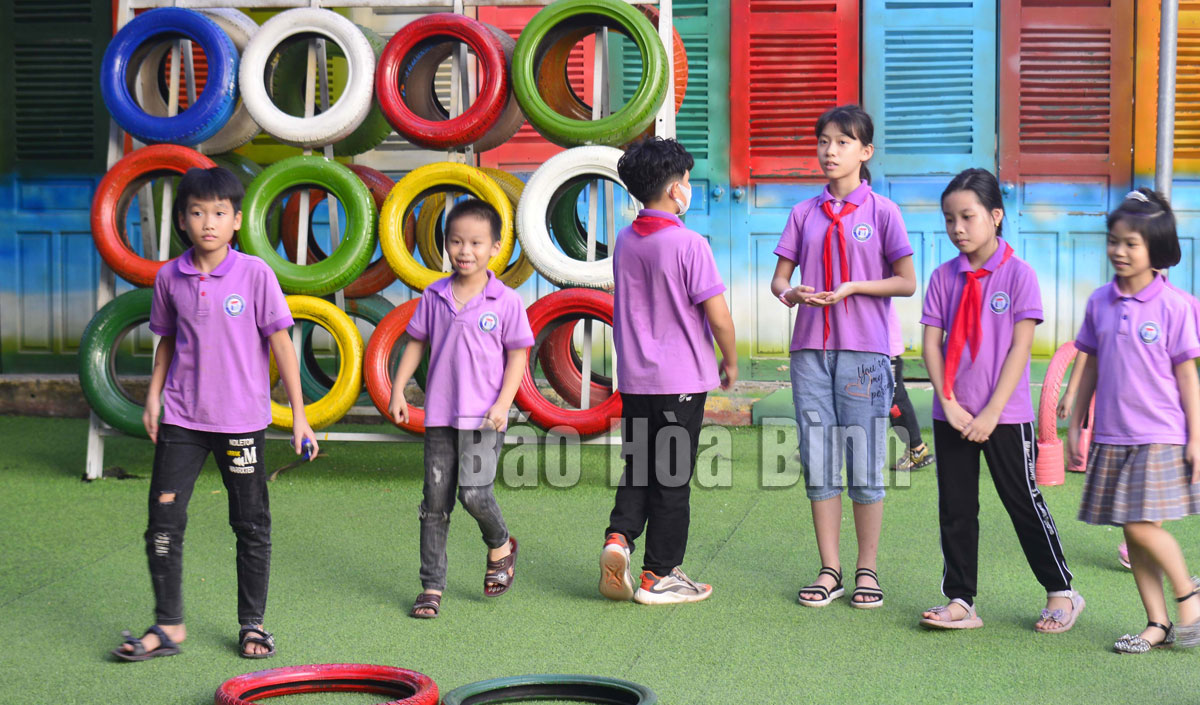
(HBO) – Hoa Binh city has recorded significant results in education and training innovation over the course of ten years of implementing Resolution No. 29-NQ/TW, dated November 4, 2013, by the Central Committee of the Communist Party of Vietnam on fundamental and comprehensive innovation in education, serving industrialisation and modernisation in a socialist-oriented market economy.

A play space for pupils built with recycled materials
at Song Da Primary School in Hoa Binh city.
Attention has been paid to planning school system, investing
in building infrastructure facilities, equipping schools with learning and
teaching tools and materials.
Many effective and creative education models have been
implemented in the city, including a play space for
pupils built with recycled materials at Song Da Primary School, friendly
library models at Le Van Tam Primary School and Sao Mai Kindergarten. These
models have effectively supported teaching and learning, as well as fun
activities for students.
Thanks to the great efforts of the municipal authority, the
quality of teaching and studying; and educational management work has been
improved. The curriculum and teaching methods have been renewed at all
educational levels, basically meeting requirements for educational and training
reform.
So far, the city has 50 schools that meet national
standards, accounting for 74.6% of the total. All schools in the city have
built plans to better the quality of teaching and studying activities,
contributing to improving the quality of overall education.
Moreover, over 90% of teachers in the city have shown a good
ability to use information technology effectively in preparing lessons. Out of
28 schools, 19 are applying electronic grade books, and 9 schools are piloting
electronic lesson plans.
In recent years, the Department of Education and Training of
Hoa Binh city has been continuously presented with certificates of merits and
emulation flags of the Chairman of the People's Committee of Hoa Binh province
for its achievements in education movements in the locality./.
More than just an information technology teacher, Bui Van Nien is an inspiring figure who has nurtured the scientific curiosity and creative spirit of students in Vietnam’s ethnic minority communities.
Da Bac is the most disadvantaged mountainous district in Hoa Binh province, with ethnic minorities accounting for about 90% of its population. Over the past years, the district has mobilised resources to implement ethnic policies to improve the quality of life of local people.
In recent years, Hoa Binh province has consistently prioritised the protection, care, and education of children, particularly those from ethnic minorities and disadvantaged backgrounds, by creating a safe, healthy, and nurturing environment for their all-round development.
The Steering Committee for Tobacco Harm Prevention and Control of Hoa Binh province, in coordination with the Tobacco Harm Prevention and Control Fund, held a ceremony on May 28 in response to the World No Tobacco Day (May 31) and the National No Tobacco Week (from May 25 to 31). The event was chaired by Nguyen Van Toan, Standing Vice Chairman of the provincial People’s Committee and head of the Steering Committee.
Since 2021, the Center for Industrial Promotion and Industrial Development Consulting (CIIDC) under the Department of Industry and Trade has been implementing a school lighting model as part of the plan for using energy efficiently and economically in Hoa Binh Province in the pẻiod of 2021 - 2025. This model not only aims to improve the learning conditions and enhance the education quality, but it also promotes the message of energy saving, energy security, environmental protection and contributes to the goals of socio-economic development.
In the 2024 - 2025 school year, the entire Hoa Binh provincial education sector includes 520 educational institutions and schools. Among them are 13 ethnic boarding schools with 153 classes and 4,487 students. Four of these schools have met national standards, reaching 30.7 percent.



